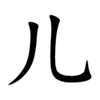儿
| ||||||||
| ||||||||
Translingual
| Traditional | 兒 |
|---|---|
| Shinjitai | 児 |
| Simplified | 儿 |
| Stroke order | |||
|---|---|---|---|
| Stroke order | |||
|---|---|---|---|
 | |||
Han character
儿 (Kangxi radical 10, 儿+0, 2 strokes, cangjie input 中山 (LU), four-corner 22010, composition ⿰丿乚)
- Kangxi radical #10, ⼉.
Related characters
- 兒 (Traditional form of 儿)
Descendants
- ㄦ (Zhuyin alphabet)
References
- KangXi: page 123, character 1
- Dai Kanwa Jiten: character 1336
- Dae Jaweon: page 257, character 21
- Hanyu Da Zidian (first edition): volume 1, page 264, character 4
- Unihan data for U+513F
Chinese
Glyph origin
| Historical forms of the character 儿 | ||||
|---|---|---|---|---|
| Shang | Western Zhou | Shuowen Jiezi (compiled in Han) | Liushutong (compiled in Ming) | |
| Bronze inscriptions | Oracle bone script | Bronze inscriptions | Small seal script | Transcribed ancient scripts |
 |
 |
 |
 |
 |
Pictogram (象形) – a standing person. A radical form of 人 (rén).
Etymology 1
| For pronunciation and definitions of 儿 – see 兒 (“child; one's own child; son; etc.”). (This character, 儿, is the simplified form of 兒.) |
Notes:
|
Usage notes
Japanese
Usage notes
儿 appears only as a radical in Japanese.
Korean
Vietnamese
Han character
儿: Hán Nôm readings: nhân, nhi
- This term needs a translation to English. Please help out and add a translation, then remove the text
{{rfdef}}.
References
This article is issued from Wiktionary. The text is licensed under Creative Commons - Attribution - Sharealike. Additional terms may apply for the media files.